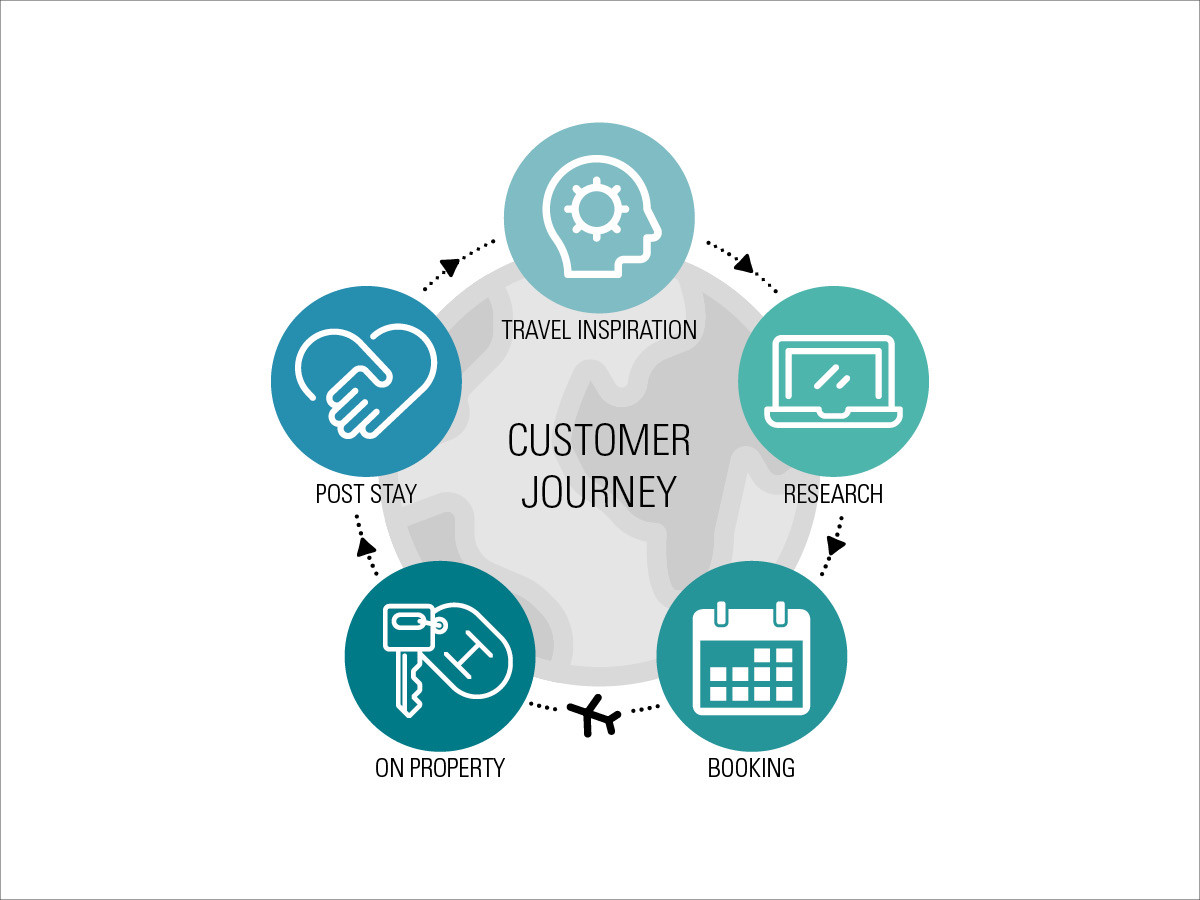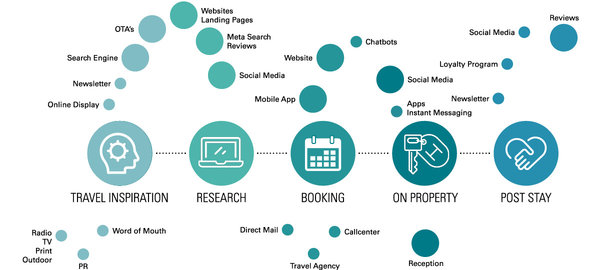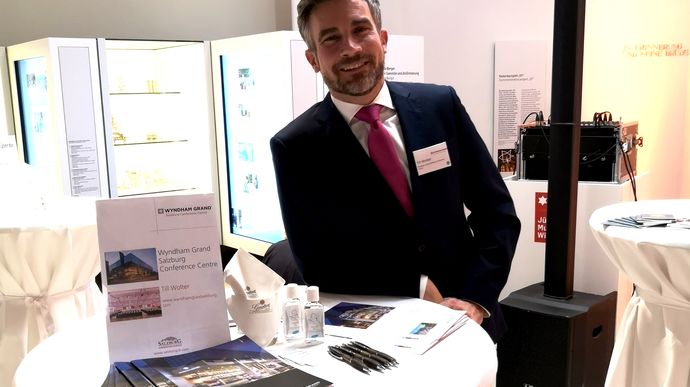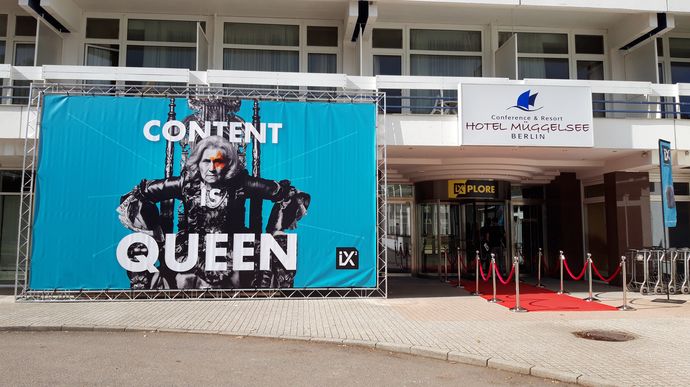The hotel business along the customer journey
A journey with the GCH Hotel Group

The hotel is booked, the suitcase is packed and the journey can begin – but what prompts the hotel guest to book a particular hotel? To answer this question, Customer Journey Mapping comes into play, which involves precisely that: the visualisation of the customer’s journey with the relevant product.
Technology is changing. And in the course of the current digital transformation, it is not just current markets that are changing rapidly, but above all, the customer’s wishes. Buying behaviour is more complex and the customer is optimally informed: customers obtain relevant product information for themselves – and do so via multiple devices. It therefore makes sense to put the customer at the centre of any activity and to analyse how and on what channels they interact with the company.
‘You’ve got to start with the customer experience and work backwards to the technology’ – Steve Jobs
Like many successful companies, GCH Hotel Group puts its customers centre-stage with the help of the Customer Journey by visualising the customer experience in a clear and concise manner and making the customer aware of the individual points of interaction with the product. Ultimately, the objective is to understand the customer in the best possible way.
That is why the customer is your most important employee, the one you can learn from all the time – because nobody is better at uncovering a company’s mistakes. In addition, a completely new dynamic is brought into the daily business routine: you become aware of which interaction points have perhaps not been served, or insufficiently served. Agile working means that the GCH Hotel Group adapts to ever-changing customer requirements and provides employees – the strategists in the headquarters, the marketing, sales and revenue teams as well as hotel staff – with the holistic customer view in a transparent manner. In doing so, it also reveals the significance of individual departments’ work for the final conversion. Even if it is often not possible to influence or anticipate consumer decisions, it is important to understand them.
The Customer Journey with GCH
Hotel guests proceed through these five phases of the Customer Journey:
1. Inspiration for travel
You want to travel...
The basis for every hotel booking is first and foremost the wish or the need to travel. A variety of impulses create this inspiration – whether through a conversation with friends, a TV feature or targeted advertising, the customer is constantly reminded about travel. The potential customer has access to various online and offline channels to provide inspiration. Which does the GCH Hotel Group use?
Our hotels appear on Facebook and Instagram and in our newsletter, arousing the interest of diverse customers through city trip advice and information, insider tips, hotel information and special offers designed to awaken interest in travel. At best, this is when interest in the hotel develops – but actual booking intentions are still a long way off.
2. Research
You want to travel, but don’t know where to go?
If a person has decided to travel to a specific destination, they then face the choice of accommodation: hotel or apartment? If the person opts to stay in a hotel, they will find countless other online hotel offers alongside our own. The customer now enters the research phase – in addition to Google, Booking.com and HolidayCheck are the best-known platforms for comparing various hotel offers. It is therefore important to be present on these channels, to provide good content and to maintain it.
With a few hotels selected, the next step is to research hotel reviews and evaluations – friends, Google, Facebook and OTAs offer popular channels for studying the experiences of previous guests and providing crucial information that can assist in deciding for or against a booking
Information that helps the potential guest to decide:
- Positive customer reviews
- Illustrative and clear information material on the website and the meta search pages
- Visual stimuli to consider: product presentations (picture & video)
- Information on social media
3. Booking
Now comes the purchase decision...
At this point, the customer takes the decision for or against the hotel. But if the customer has decided to book our hotel, they do not necessarily do this straight away. This phase can last hours, days, weeks or months, but as a rule, the booking takes place via one of the three following routes: the hotel website (or corporate site), an OTA or via email/telephone.
In each case, the booking process must be set up to be as easy as possible: a quality user experience and a responsive website, well-summarised content and a simple, intuitive and quickest-possible process flow. And most important of all: transparent and user-friendly price communication.
However, things are far from over – the Customer Journey shows how much further the journey continues.
4. On-location/service
Customer satisfaction has top priority
The truly crucial phase for the hotel trade is the guest’s stay – this is where the decisions are made as to whether the guest returns and whether they recommend the hotel to friends and acquaintances. In addition to the obvious factors such as the cleanliness of the rooms or good service, this phase is critical in determining whether positive or negative reviews are given – the handling of complaints is vital and should be regarded as an important touchpoint within the customer journey.
5. Post-stay/loyalty
We want to retain the customer
The goal of every hotel management group, indeed of every hotelier, is to secure the guest’s loyalty to the hotel and, where applicable, to the brand. A vast number of factors have a role to play in this respect. Although it’s not possible to influence everyone, it is important to persistently a) motivate the client to re-book, b) thank them for their loyalty/a possible next booking, and c) regularly remind them of their positive stay.
The possible channels are first and foremost a newsletter and the brand’s respective loyalty schemes. Various sales discounts, travel ideas, offers and the like can be distributed by these means. The corporate blog also serves as a popular means of motivating customers to renew their desire to travel – this is how the journey ends and starts again.
Why it is so important to show the specific touchpoints
Advantages of the Customer Journey
The fact is: the customer has a problem and the product offers the solution. For the customer to be able to make the right decision, they must know that this solution exists, what characteristics the solution has and what advantages it has for them. This works best with the Customer Journey: it provides the basis for the definition of appropriate activities that reach the customer – or could potentially reach them – and thus enable a more customer-specific and more efficient alignment of all strategic and operational measures targeted at the booking decision. But that is not all: obstacles and shortcomings in the company can also be visualised in this way and can therefore be addressed or avoided faster and more precisely.
With the Customer Journey, the GCH Hotel Group gets to know the customer and their constantly changing wishes, sees things from the customer’s perspective and provides the right information at the right time throughout the journey. In this way, the customer’s digital journey becomes the key to the actual journey to one of the many destinations of the GCH Hotel Group.
Editor: Christina Hahn











